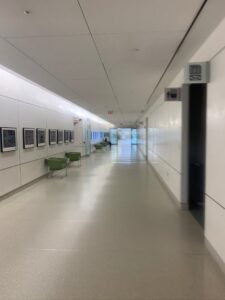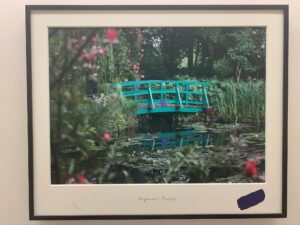Takeaway
In a time of physical distancing, stepping out of our comfort zone to find creative and unconventional ways to connect with patients and colleagues can bring us together.
Lifelong Learning in Clinical Excellence | July 20, 2020 | 6 min read
By Kamna Balhara, MD, Johns Hopkins Medicine, Sarah Clever, MD, Johns Hopkins Medicine
This is the second piece in a series of regular reflections on art by Dr. Kamna Balhara (@KamnaBalharaMD) and Dr. Sarah Clever (@SarahCleverMD1). As incoming fellows in the Harvard Macy Art Museum-based Health Professions Education Fellowship, they are thrilled to be carrying on the CLOSLER art challenge series established by Dr. Margaret Chisolm and Dr. Flora Smyth Zahra last year. Even though we can’t view art in person during the pandemic, there is still art all around us. The authors found inspiration in the halls of their workplace.
“Don’t talk to strangers.”
This childhood edict echoed in our heads as we set out to do just that—talk to people we didn’t know.
We hatched the idea while developing a new project that would tap into the healing power of art in the hospital. But first, we wanted to know, do people passing through the hospital notice the art on the walls around them? Does it prompt reflection, as we might hope? How do they feel about it? Do they feel anything about it?
We decided to simply ask
On a typical weekday afternoon in early March, we stood, still and nervous, in a busy hospital hallway, looking at a row of regularly spaced framed images on the wall across from us—Spencer Finch’s 26 photographs of a bridge over a small pond, each just a little different from the next, echoing Monet’s color palette from his paintings of the same subject at Giverny. Around our little oasis of observation flowed a current of people. Conversations and murmurs ebbed and eddied around us as the crowd swelled or slowed, and a staccato chorus of footsteps dopplered towards and away from us. In this disconnected flow of people, we sought connection. Our aim for the afternoon was simple in theory, yet daunting in practice—stop these passersby and ask them to tell us what they thought of the photographs displayed in the hallway. At first, it felt awkward to engage strangers in conversation. We weren’t physicians in our expected roles of interacting with patients or colleagues, we were just people asking other people to look at art with us.
A group of physicians wrapping up their rounds paused to round with us on the photographs. A hospital administrator in between meetings stopped with us in the hallway. A member of the patient transport staff shared her impressions in between assignments. We spoke with nurses and their trainees going to lunch, a security guard on a break, and residents who looked, in turn, harried, then intrigued and partly bemused, by our request.
Each person we spoke with shared something new, how the art made the hallway less plain or sterile, or how it made it seem not like a hospital at all, and, instead, like an art gallery. Others asked us questions about the art, “Why the different colors? Why in this hallway?” Some told us things we didn’t know: “You know, the entire palette of the entire building is based on Monet’s Water Lilies.” The repetition of images seemed tiresome to one observer (“Why this image, why the same image 20 times? It looks like post-it notes!”). Yet another, however, told us, “People don’t always read the plaque and that’s why they think to themselves, “Why the same picture over and over?” The repetition brought the joy of discovery to some, who made it a point to notice one or two new things every time they passed through the hallway. Another passerby found the repetition of nature scenes a balm for anxiety.
This art was a nexus for connection and comfort within the hospital. One visitor shared with us how she found art therapeutic, how a group of her friends spontaneously breaking into song comforted a critically-ill family member. For others, the same photographs served as a nexus for connection and comfort with those outside the hospital; one visitor enjoyed how the photographs reminded her of images of nature her father used to capture. A staff member told us that he sends pictures of the hallway to share with a family member, who then displays the enlarged versions in her home. A retired employee reflected on how she’s seen such welcomed changes over the years, remarking that, “the art gives a new impression as to what this hospital is all about.”
Indeed, the art gave us a new impression of what each individual we spoke with was all about, and the richness of their inner lives. It also gave us a new frame through which to look at both ourselves and those who surrounded us on a daily basis. Finch’s alphabet of 26 photographs allowed us to discover a new shared language. These brief conversations sparked a connection that years of sharing the same hallway would not have achieved.
As the sharing from passersby continued, each person walking down the hallway became a precious gift of humanity, bringing their experiences and insights, waiting only for us to ask. People related vulnerable and personal details with complete strangers—with us. We felt lucky to be engaged in a project that gave us a chance to discover the wonder of the people around us. We left that afternoon invigorated, setting a date to return as soon as possible to continue these spontaneous moments of conversation.
Then, things changed
We’ve both walked that hallway multiple times since that day in early March. The hallway is now usually empty. There are often no footsteps but our own, with unwelcome solitude taking up an uncomfortable amount of space. The hallway feels like a vault that holds all the whispers and snippets of previous conversations, the photographs on the wall seem like lonely sentinels witnesses to a time past. It captures the sense of isolation, separation, and loss many of us are feeling— interpersonal connection is one of the many casualties of this pandemic.

But even as there’s much that has changed, the unexpected wonder of other humans remains if we are just brave enough to reach out and find it. We found connection by taking a risk and engaging strangers in conversations in a hospital hallway. Art allowed us to forge intimacy in unexpected ways, by functioning both as a mirror for self-reflection and a lens by which to explore our world. Spencer Finch’s photographs all looked the same at first glance, but a closer look revealed subtle and wondrous differences in color, framing, and composition—a cascade of flowers in one corner, the leaves of a weeping willow raining down in another. The faces of passersby in a hallway, including our own, perhaps seemed interchangeable, until the moment we took a chance to engage, to truly see each other. It took energy to do it, and there are days now when so much has been wrung from us that none remains. But perhaps we should use any remaining energy to step out of our comfort zones to find creative or unconventional means to connect from six feet away with our patients, our colleagues, or an acquaintance in a hospital hallway. The gift of finding each other’s common humanity is worth it.
If nothing else, it helps us not be strangers.


